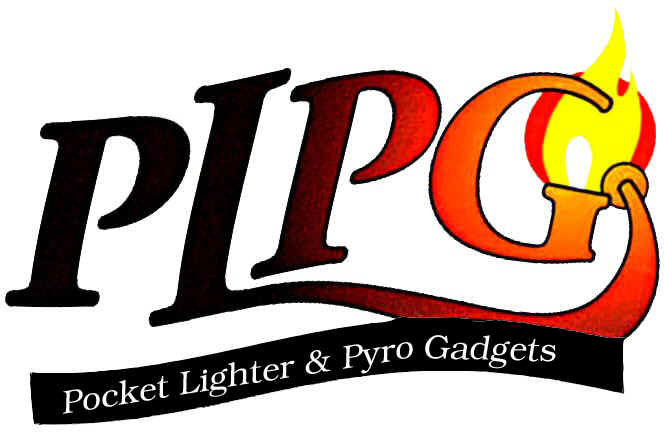My collection
I started collecting Ronson petrol lighters when I wanted a good quality lighter. I was tired of the disposable ones, and I had always wanted a Varaflame Premier gas lighter, which I remembered from my younger days, so I started searching the internet for it. I found one, and it worked well, but while searching eBay, I found a huge amount of old beautiful petrol lighters, and so I was hooked....
Much of the information on these pages comes from Urban K. Cummings book "Wick lighters 1913-2000", which all collectors should have. It contains a huge amount of information about Ronson petrol lighters. I have also learned a lot from Robert Adams, a walking encyclopedia and the best repair man of these lighters out there (link at the bottom of the page).

*
The Banjo
The Banjo is of course the pride of my collection. They were made from 1926, and just for a short time, since the more stream lined De-Light came in 1928 and took over. It`s the worlds first "one motion automatic lighter", as the Ronson slogan said at the time: "Press it`s lit, release it`s out". Hight 2-1/4" or 57 mm.
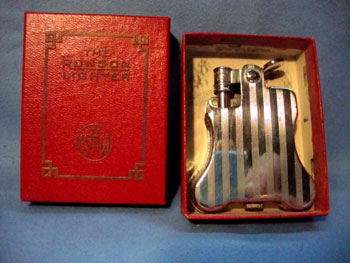
*
The Wonderliter
The Wonderliter is a Strike lighter, and was first made in 1913. It was the first lighter produced by the Art Metal Works, which later became The Ronson Company. The lighter being a Strike lighter, means that it has a metal wand which is contained in a cotton filled fuel chamber where the asbestos wick at the end of the wand is soaked in fuel. The lighter has a flint strip attached to its outside, where the wand can be struck like a match, thereby igniting the wick at the end. This lighter has the flint strip at the bottom. My lighter has the inscription: "CHRISTMAS 1913 COMPLIMENTS GERMAN AMERICAN INS. CO OF NEW YORK". Hight 2-1/4" or 57 mm.
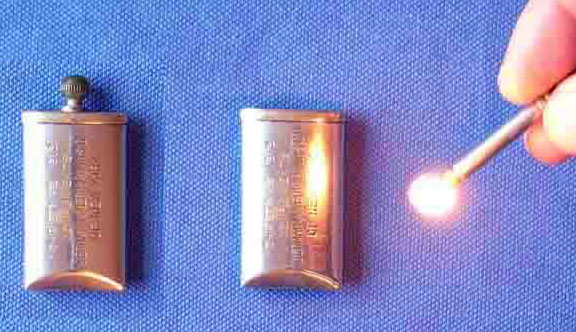
*
The Octette
The Octette is a Touch Tip lighter, which means that it has a wand like the Wonderliter. Instead of striking the wand, it`s used to push down the knob between the spark wheel housing and the wand hole, seen on the picture. This releases a spring mechanism which spins the spark wheel and lights the wick on the wand. The pre WW II models can be identified by the square spark wheel housing and a round shaft wand, as opposed to the post WW II lighters which have a curved spark wheel housing and a square shaft wand. The Urban Cummings book lists 83 Touch Tips, many in various finishes, and all beautiful works of art. The Octette was designed by Ronson`s chief designer at the time, Frederick Kaupman, and it was the first Touch Tip lighter. Made from 1935. Hight 3-5/8" or 92 mm.
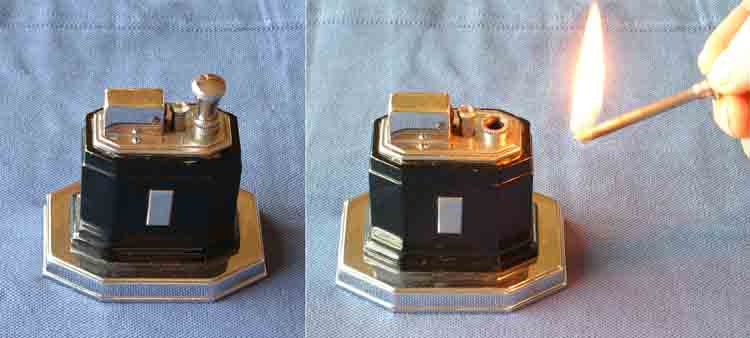
*
My Strike Lighters
Even though the Wonderliter and the Lite-O-Rite are Strike Lighters too, they are presented elsewhere on the page. The Wonderliter because it was the first Ronson lighter, and the Lite-O-Rite simply because I thought it suited better together with the Penciliters. The Strike lighters work like I`ve explained under the Wonderliter further up this page. Like the vast majority of Ronson lighters, most Strike lighters were made in various finishes, such as different kinds of bronze, polisher chrome and copper plate. A lot of them were designed by John Skiba who was a plaster model maker at Ronson for 25 years. As with the Touch Tips, the Strike lighters are true pieces of art. Many specialize in collecting these beautiful small sculptures, which is very understandable.
John Skiba was a plaster modeler and a designer, responsible for many of the Strike Lighters. A true artist, and I`m sure he was a big part of The Art Metal Works and The Ronson Company`s success.
The Monkey
Bronze finish. Made from 1939. Hight 3-3/4" or 95 mm.

Two Houn`Dogs
Both made from 1934.
Polished chrome. Hight 4-1/2" or 114 mm.
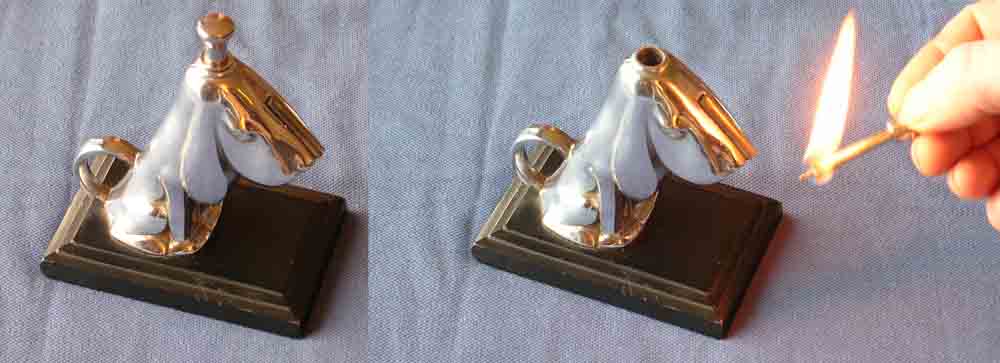
Copper plate. Hight 4-1/2" or 114 mm.
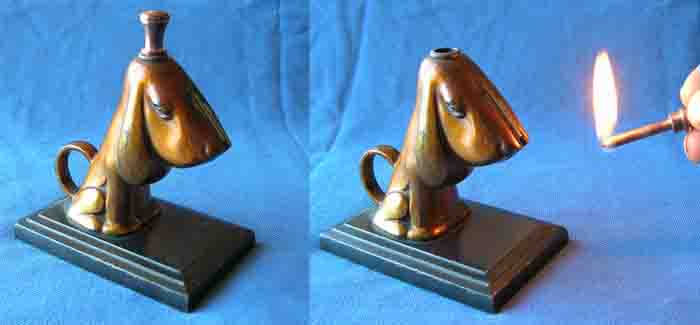
Bulldog With Ashtray
Bronze finish. Made from 1938. Hight 3" or 76 mm.
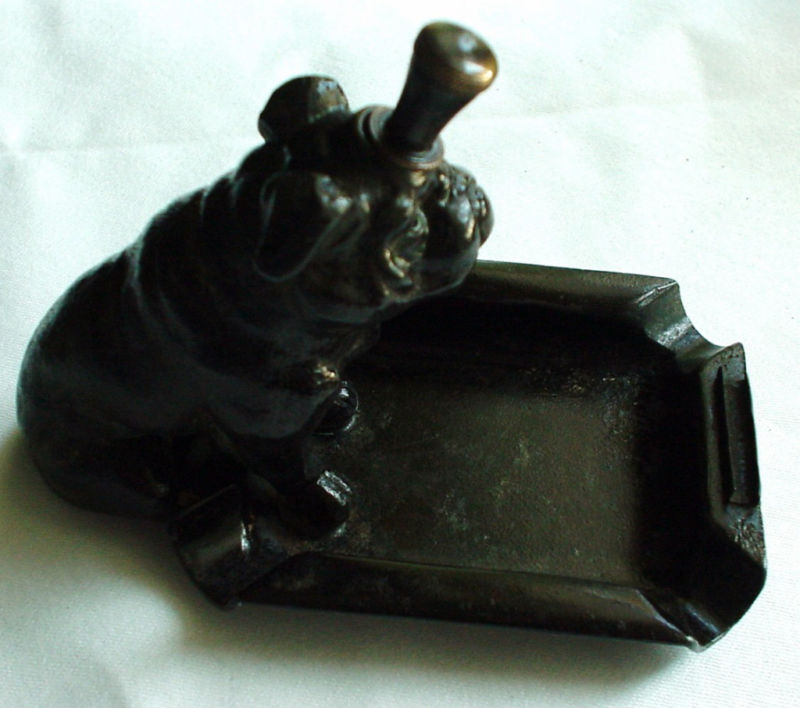
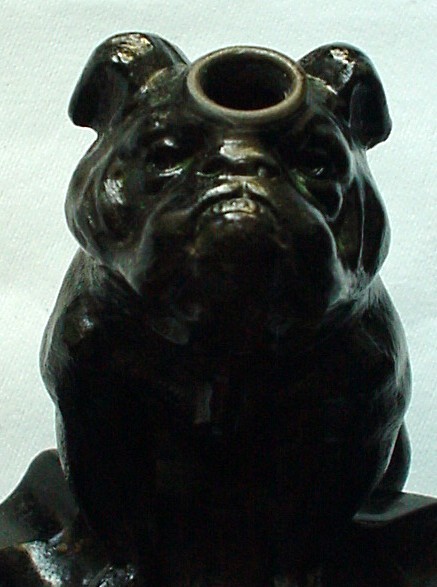
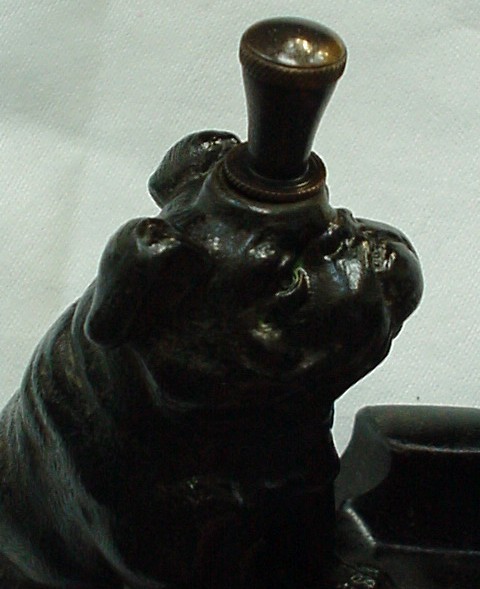
(new pictures soon)
*
The Lite-O-Rite and the Penciliter
The lighter in the upper two, and in the second left photos below, is a strike lighter named Lite-O-Rite, and it was first made in 1934. As seen in the upper right photo, pulling out the top of the pencil reveals the flint strip, else it works like the Wonderliter. This is the second version with the combination of pencil and lighter that Ronson made. It was made only for a short period, since the Penciliter at the bottom left was also introduced that year. That lighter is a one motion automatic lighter, and is often referred to as the "Square Top" because of the shape of its snuffer cap. The last three lighters on the right are also Penciliters. These ones have a rounded snuffer cap, and were first made from 1948. The upper one of these three is an English made painted version. The one below that, is a rhodium plated US made version, and the one at the bottom right is a 1/20 14K gold filled version. Gold filled refers to the way in which the coating is attached to the material. The method is that rolled gold plates are bonded to the material underneath, by heat and pressure. This method means that the coatings are 50-100.000 times thicker than regular plating, and lasts for a lifetime without being worn through. 1/20 14 K means that 1/20 of the weight of the golden pieces in an item, is 14K gold. The regular ball point pen was first sold in the US late 1945, so I guess that`s why they are all pencils.
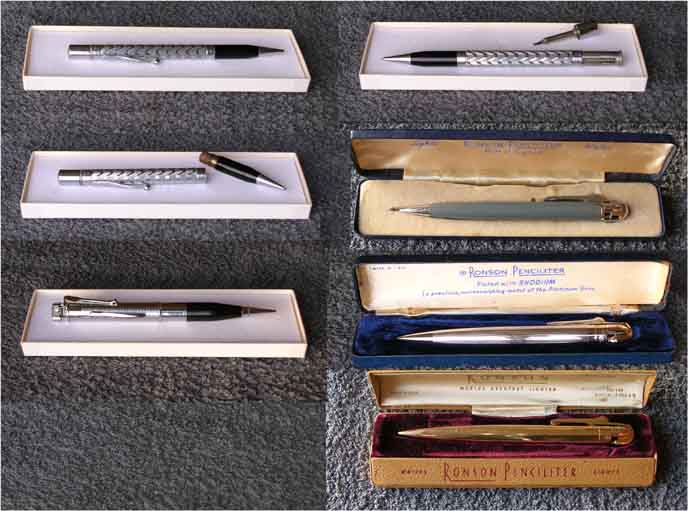
*
Mastercase
Made from 1933, and for almost 20 years. The Mastercase is a combination of a lighter and a cigarette case which holds 14 regular size. This one, with the New Standard fitment, is a pre WW II model. Hight 4-1/4" or 108 mm.
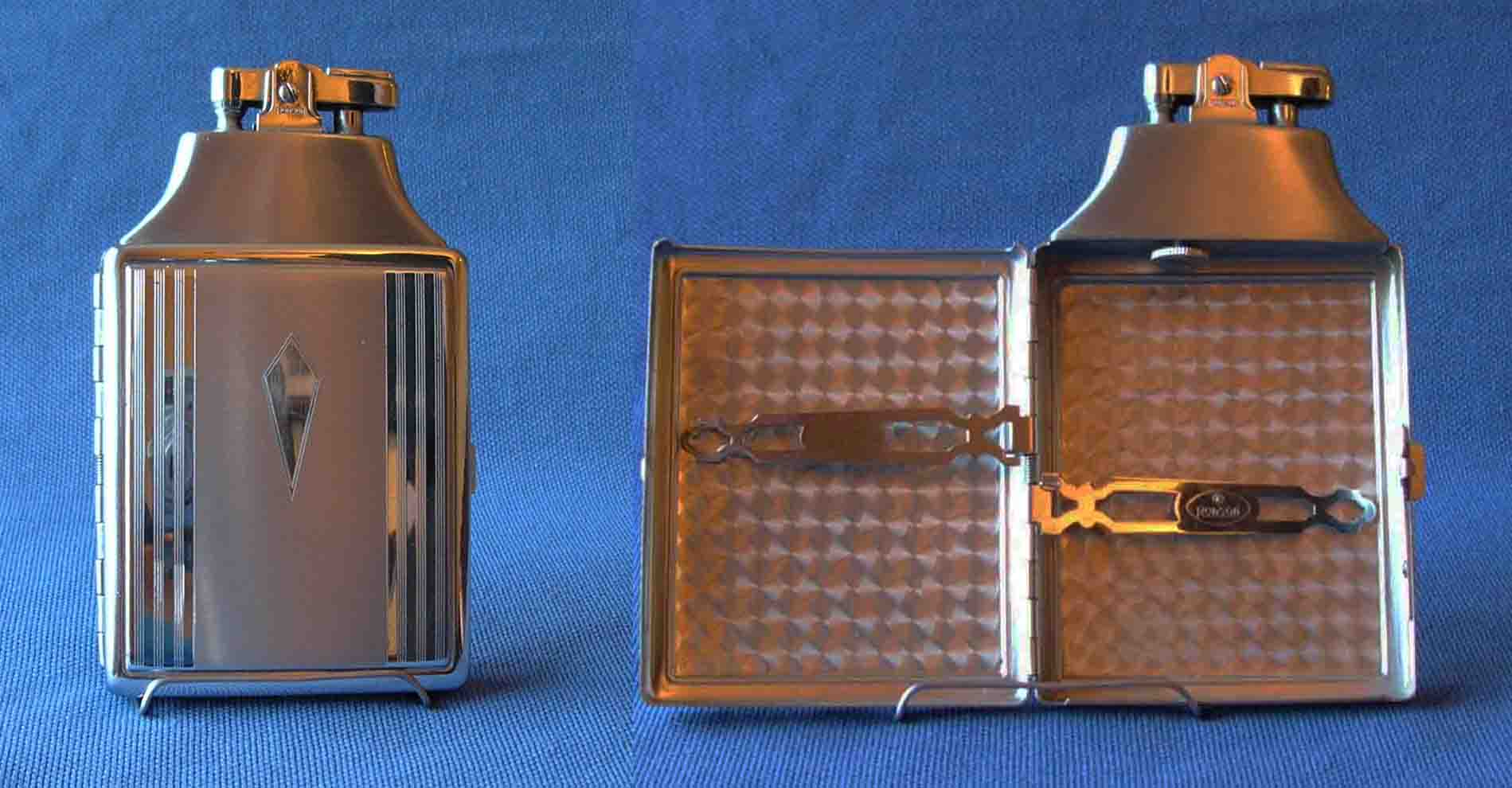
*
The Standard De-Light
This is the Standard De-Light which came after the Banjo. It came in 1928, and the earliest models can be identified by not having a patent number at the bottom, it only says "PATD. OTHER PATS. PDG.", and the fuel screws which has no "coin slots". The four to the left, are the first generation early Standard-De Light, the two to the right are the second generation early Standard De-Light. There was not a long time between the two types production start. The one with the blue shagreen (stingray) leather, has been "re wrapped", The De-Light lighters was not delivered with that kind of leather. The standard came with the same fitments as the Princess shown further down the page. Hight 2" or 51 mm.
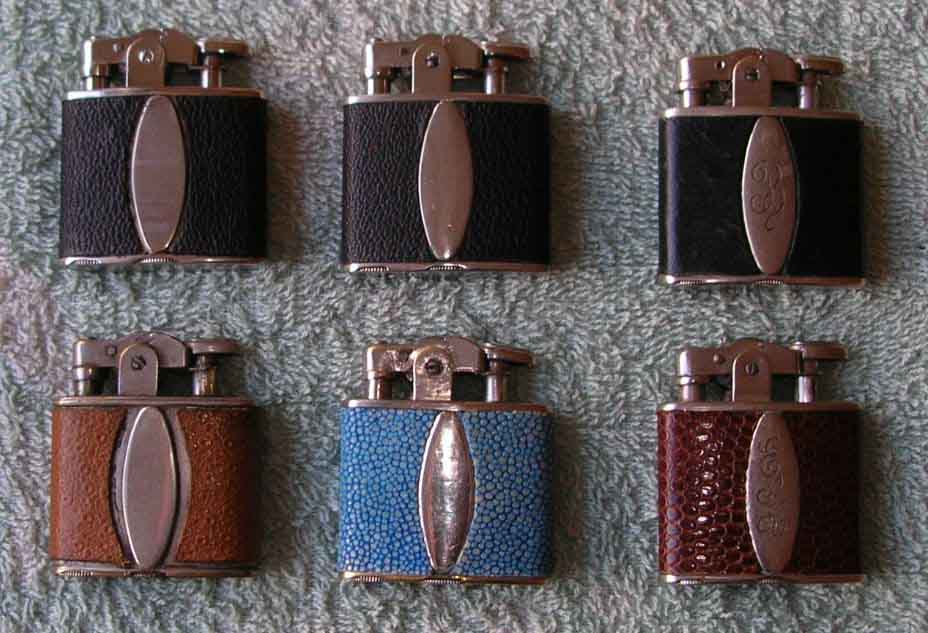
Fuel screws without and with "coin slots", and difference in patent engravings.

*
The Standard
The Standard was the working horse of the Ronson lighters, and was produced from 1928 through 1953, in at least 76 designs. Shown here, are three Standards with the New Standard fitment, but it was also made with all the fitments shown in the Princess picture below. Together with the Whirlwind, they were the only lighters produced during WW II, when a lot of factories were put into war production. During the war, both the Standard and the Whirlwind were painted black to prevent corrosion, as a lot of them were shipped out to American soldiers all over the world. Earlier models are shown in the Standard De-Light picture. Hight 2" or 51 mm.
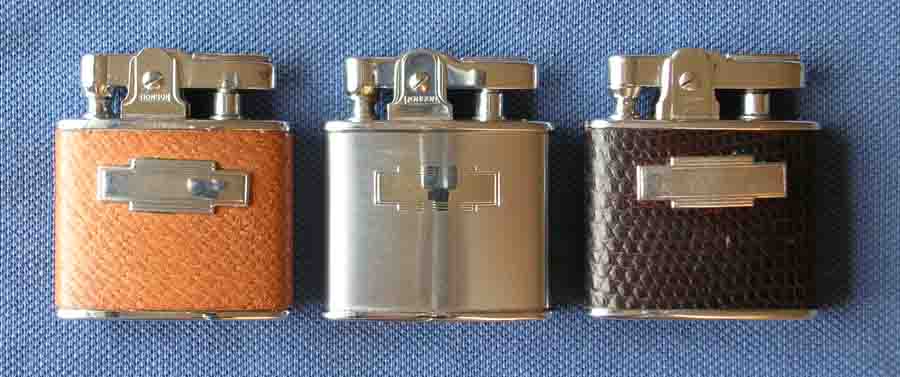
*
The Princess
These are my Princess lighters. They are the same height, but both slimmer and narrower than the Standard. They were made first in 1929, as a typical womens lighter. Underneath is shown the different fitments The Princess and the Standard were delivered with. The upper left, has the early De-Light fitment. The upper midle actually has the wrong snuffer cap from a late De-Light, I will have to change that as soon as I get a spare. (Be careful when you buy). The upper right one, (without it`s leather wrapping), has the late De-Light fitment. The lower left, has an Old Standard fitment, and the two remaining have The New Standard fitment. The Princess Frat in the upper left corner, is by Cummings rated as extremely rare, which is the highest grade of how rare the lighter is. Hight 1-7/8" or 48 mm.

*
The Gem
The Gem is a small and very beautiful lighter, one can easily understand how it got it`s name, it`s a real gem. It`s a tiny bit taller than the Princess, but both slimmer and narrower. The one to the left is gold plated, the middle one has a beautiful floral enameling, used on many of the Ronson lighters, and the one to the right has the tortoise enameling. It was made from 1937. Hight 2" or 51 mm.
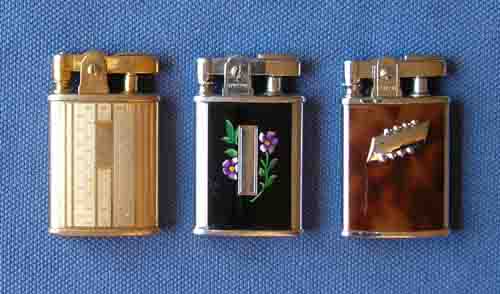
*
The Adonis
The Adonis came in 1947, with a completely new design and a new fitment. It was the first new model after WW II. Hight 1-3/4" or 44 mm.
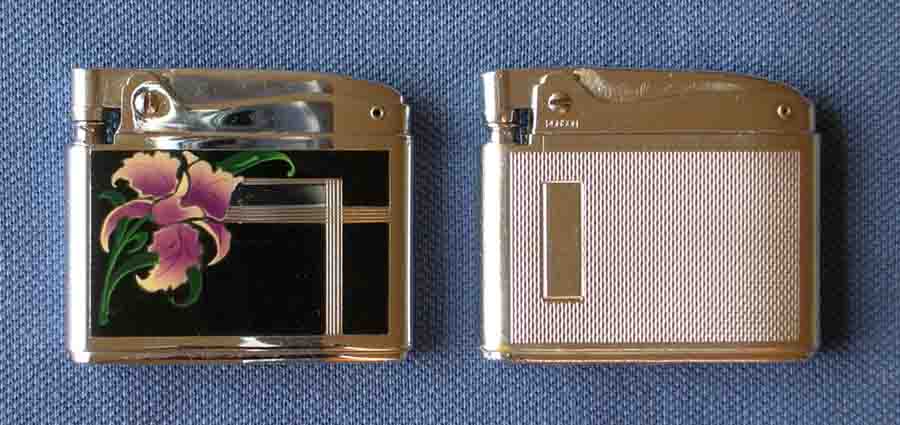
*
The Whirlwind
The Whirlwind is a big lighter. It`s taller wider and thicker than the Standard, and came in 1941. These lighters have wind shields which can be pulled up from the body of the lighters for outdoor use. The one to the left is a Whirlwind Imperial, which was introduced in 1956. The Imperial has an Essex fitment, which came with the Essex lighter in 1954. It also has a swivel base, which means that the bottom plate is pulled out a couple of millimeters and turned to add fuel. The one to the right, is an early model, which can be identified by having "RONSON WHIRLWIND" and the patent numbers engraved on the wind shield. The lighter has never been used, and the discoloration on the shield is oil, which I believe is the protective oil which the lighters was delivered with from the factory. Maybe it hasn't been discovered with the shield down, while cleaned. The middle one and the Imperial have tortoise enameling, which was popular on a lot of Ronsons lighters. Seen here with shields both up and down. Hight 2-1/8" or 54 mm.
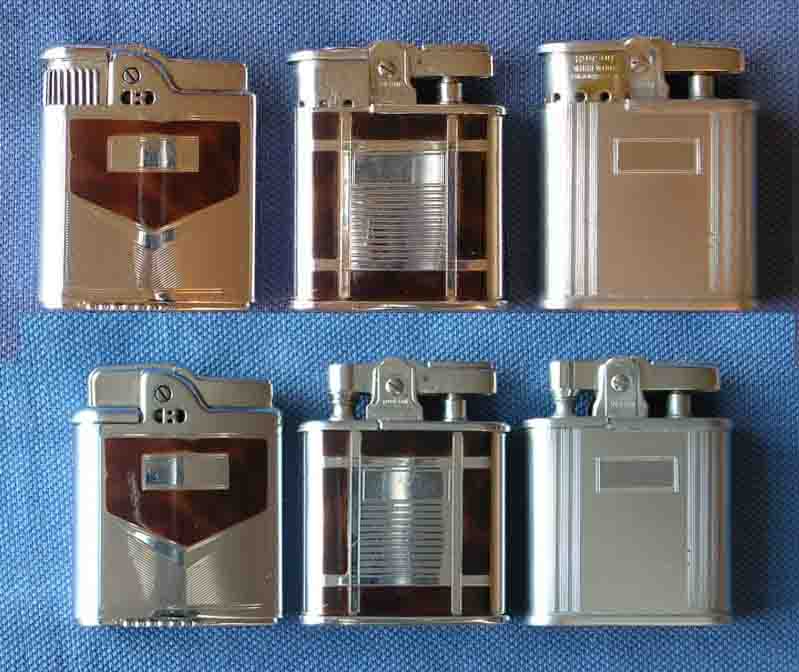
*
The Cadet
All made in England from 1959.
The Cadet family lighters are easily recognized by their square corners. From the upper left, is the Cadet Adonis, which came with the same system as the Zippo, where the outer cover is pulled off the body to fill petrol and to change flint. It`s thicker than the regular Adonis, and thereby holds more fuel. The Cadet with windshield, differs from the Whirlwind in the way that its shield is hinged on the fulcrum screw so it can be swung up when needed, this one has the Cadet fitment. To the upper right is a regular Cadet with a New Standard fitment. The two at the bottom, are the Cadet Mini, which is the smallest lighter Ronson made, with it`s 1-3/8" or 35 mm height. The one to the left, has the New Standard fitment, the golden one has the Cadet fitment. Hight Adonis 1-3/4" or 44 mm , with windshield and Cadet 2-1/8" or 54 mm, Mini 1-3/8" or 35 mm.
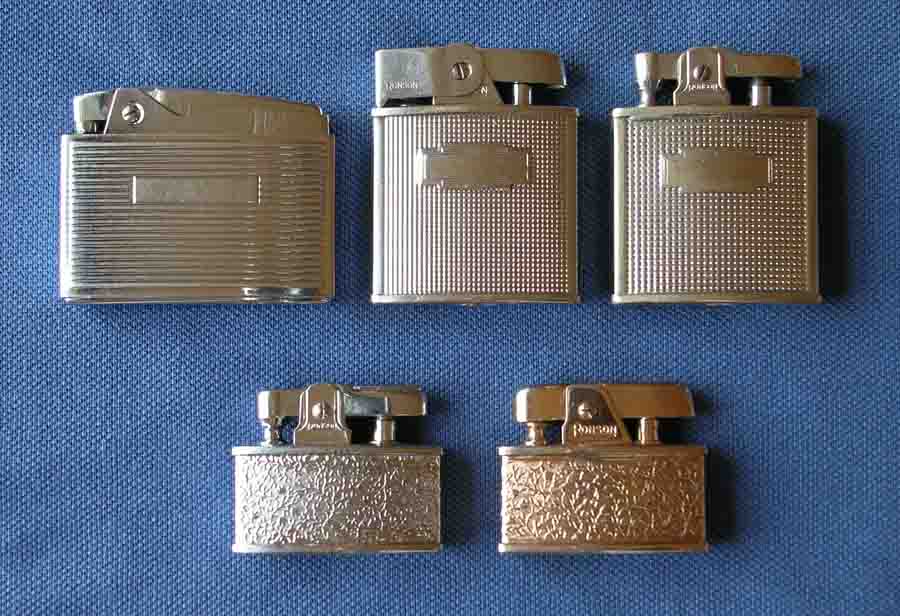
The Cadet Adonis filling system and the Cadet shape.

*
The Junior Sport
With the Old Standard fitment. Made from 1928, and one of the first successors of the Banjo. Hight 2-3/4" or 70 mm.
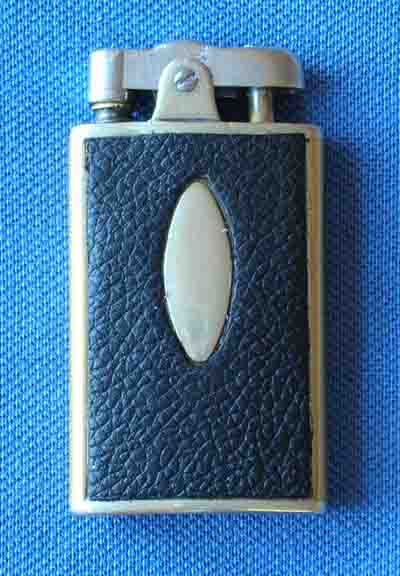
*
The Banker
With the New Standard fitment and alligator skin. Made from 1937. Hight 2-1/4" or 57 mm.
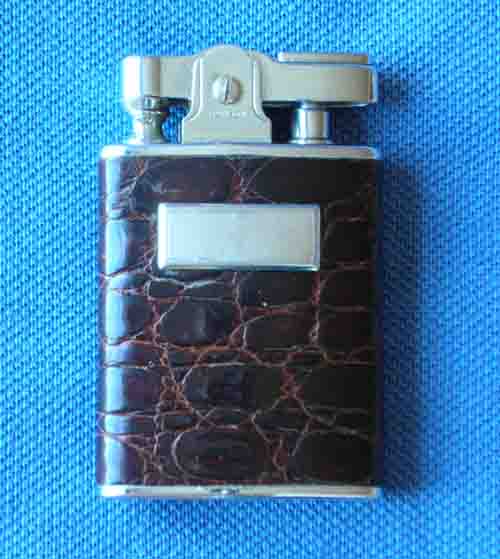
*
The Rover
With the Pioneer / Rover fitment. It was made in England, in aluminum from 1966. It has the same fuel filling and flint changing system as the Cadet Adonis. Height 2-1/8" or 54 mm.
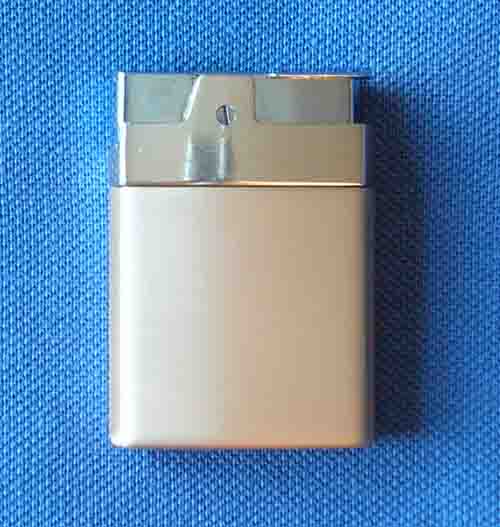
*
The Capri
Came with the Essex fitment which replaced the New Standard fitment. It has decorative ivory colored dancing cherubs on the side and was equipped with the swivel base as explained under the Whirlwind Imperial. Made from1954. Height 2" or 51 mm.
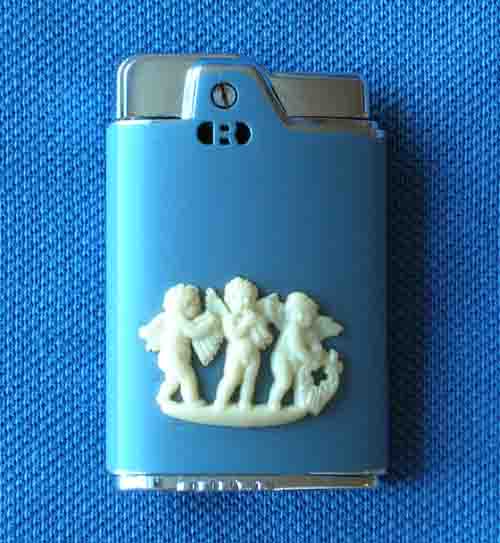
*
The Junior De-Light
A shortened version of the Princess, and the second smallest Ronson lighter after the Cadet Mini. It was the first womens lighter, and meant to fit in a ladys purse. Made from 1928. Height 1-5/8" or 41 mm.
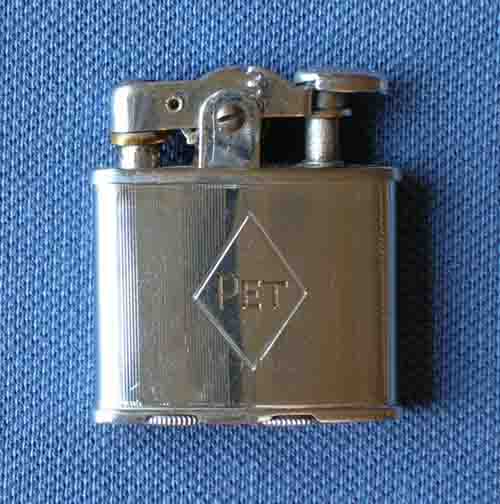
*
100 Years Anniversary lighter
I added this because it`s often sold, or advertised as a vintage, even antique lighter on eBay. Its NOT, it`s a 100 years anniversary lighter made in 1996. The shield says "Storm, Ronson since 1896". Hight 2" or 51 mm.
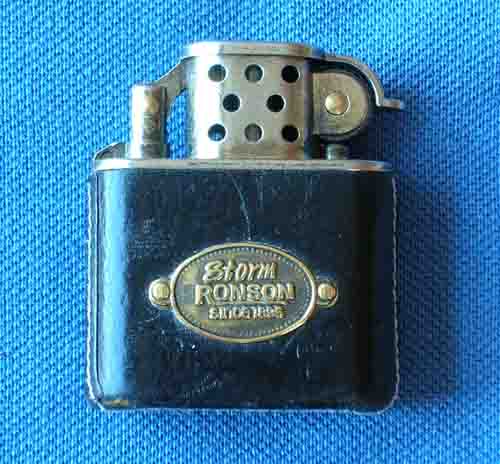
*
To compare the size of some of the lighters.

*

If they can`t fix it, throw it away.
Lighter clubs I`m a member of:
